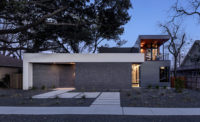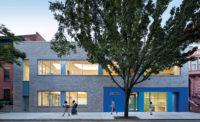72Foster by Holst Architecture
Portland, Oregon

The building hugs the busy intersection of SE 72nd Avenue and Foster Road, and is surrounded by the Portland Mercado (at bottom left of photo) and single-family homes.
Photo © Hovrtek

The building hugs the busy intersection of SE 72nd Avenue and Foster Road.
Photo © Christian Columbres

A ground-floor lounge, complete with a kitchen, opens to the back courtyard.
Photo © Christian Columbres

Paintings by Haruka Ashida Ostley, a Portland-based artist originally from Japan, adorn the lobby (shown), hallways, and ground-floor lounge.
Photo © Christian Columbres

Some units have a view of Mount Hood (through window at far left).
Photo © KLiK Concepts

Image courtesy Holst Architecture






Architects & Firms
In Portland, Oregon, a collaboration over many years between an architecture firm, a nonprofit developer, and a social services agency has set a high bar for affordable multifamily housing.
Additional Content:
Jump to credits & specifications
REACH Community Development, which provides affordable housing in Oregon and Washington, had a long-standing relationship with the Asian Health and Service Center (AHSC). After a lengthy search for a site to build housing near the AHSC headquarters in southeast Portland, REACH found a city-owned trapezoidal parking lot available for development through a public RFP in the rapidly developing Foster- Powell neighborhood. The organization engaged local firm Holst Architecture—which designed the AHSC headquarters, completed last year—to conduct a feasibility study in preparation for replying to the RFP. They won development rights and funding from the city in April 2016, and broke ground on the project, called 72Foster, in September 2017. The goal, informed by zoning requirements, was to build 100 rental units in a range of sizes, with ground-level retail meant to enliven the building’s street presence and engage with the community. Built on a tight budget, the recently completed building is located across the street from the Portland Mercado, a popular restaurant-business incubator that offers Latin American dishes from 15 food carts and stalls. An inviting public plaza at the rear of 72Foster gives breathing room to the nearby single-family homes.
Holst partner Dave Otte describes Foster-Powell as one of the last places in Portland to buy a starter home. “I think you’re going to see a whole new wave of young families moving out here, and a lot more transit-oriented, mixed-use development,” he says. This summer, the city converted Foster Road from a four-lane thoroughfare to a pedestrian friendly two-lane street bordered by bike lanes. The neighborhood is among the more diverse in the city, with a number of growing Asian- American communities. REACH CEO Daniel Valliere reports that some 27 percent of occupants identify as Asian, as compared to just 8 percent in Portland overall. As the building’s resident services provider, AHSC will offer educational, professional, and life-skills programming and support to tenants. Residents cannot earn more than 60 percent of the Median Family Income—$34,200 for one person or $48,840 for a family of four in 2018—and 20 units are set aside for Section 8–voucher holders.
Since the project is one of the area’s first multifamily buildings, the architects aimed to set the tone for future development—despite the fact that design review is not required here. Shaped like an obtuse V, 72Foster is a four-story wood-frame structure, built on a concrete podium to house a variety of street-side retail businesses, including a brick-oven pizzeria, bubble tea shop, and game store. Its low-key material and color choices lend a timeless quality, deferring to the colorful Mercado across the street. A pass-through bisects the building at grade near its vertex, creating a pedestrian connection between the single-family housing behind it and the Mercado. This space also accommodates a utility easement, where the city reserves the right to dig up a buried cable line. “Initially, it was a challenge,” says Valliere. “But now, the passageway is a feature that the neighbors and residents think is awesome.”
In deference to the neighborhood, the architects pulled the mass of the building away from the existing houses to create the plaza. And although the city does not require space for cars within such close proximity to public transit, the architects opted to add two small parking lots, containing a total of fewer than 40 spots. “We didn’t want to over-park the site, with the future of transportation moving away from cars, but we also didn’t want to be a burden on the neighborhood,” says Otte.
With a construction budget of $17 million and an overall cost of $215 per square foot, the architects used practical, reasonably priced materials that will be easy to maintain. (REACH has a 100-year lease on the property.) Thick planks of cement-board siding clad the upper stories of the building, with vertical metal trim pieces breaking up the planks to avoid visible butt joints. Orange sheet metal framing outlines the modestly sized windows to give the impression of a more generous opening. At street level, dark brick surrounds the glazed vitrines of the retail establishments, while cedar planks wrap around the building entrances and the pass-through.
Inside, a bright, airy lobby connects with a flexible lounge—complete with a kitchen—that opens to the courtyard via a folding glass wall. Energy for the common spaces of the building is provided, in part, by a 106.5 kilowatt hour solar array on the roof. Upstairs, the residential units are spread among three floors. There are 66 studios and nine three-bedroom apartments, with one- and two-bedrooms comprising the rest. “It’s a high percentage of three-bedrooms for Portland,” Otte explains. “The developer was committed to providing as much family housing as possible.” Each unit has a full kitchen and spacious bathroom, with electric heat, LED lighting, and operable windows. The mix of studios—each around 360 square feet—and larger apartments is intended to foster a multigenerational atmosphere, based on the assumption that seniors will gravitate toward the studios, and families to the larger units. Interest has far exceeded availability; five months after opening, applications were approved for 96 of the 101 apartments, with the remaining five in progress.
“Affordable housing is hard enough to build and almost impossible to maintain because of funding, so making sure materials are long-lasting and easy to replace is a trend we see in a lot of our affordable-housing projects,” says Otte. “And yet, there’s a balance to strike: how do you make something simple and durable, but also make it feel dignified and not institutional?” At 72Foster, Holst seems to have found the sweet spot.
CreditsArchitect: Holst Architecture — Dave Otte, Kim Wilson, Kevin Valk, partners; Lee Jorgensen, Jake Watkins, Kristin Solomon, Bryce Tolene, Lauren Sanchez, Keri Woltz, Cory Hawbecker, project team
Engineering: MFIA (mechanical, plumbing); Samata (electrical); ABHT (structural); Humber Design Group (civil)
Consultants: PLACE (landscape); Acoustic Design Studio (acoustics); Professional Roof Consultants (building envelope); Housing Development Center (development)
General contractor: LMC Construction
Size: 79,600 square feet
Cost: $24 million
Completion date: March 2019 |
SpecificationsFiber cement siding James Hardie
Composite metal panels Alpolic Materials
Sliding storefront Nanawall
Aluminum storefront Kawneer
Moisture barrier VaproShield
Wood deck pavers Bison Innovative Products
Acoustical ceilings MBI Products
Plastic laminate Wilsonart
Solid surfacing DuPont
Resilient flooring Patcraft
Carpet Patcraft, Mohawk Group |











